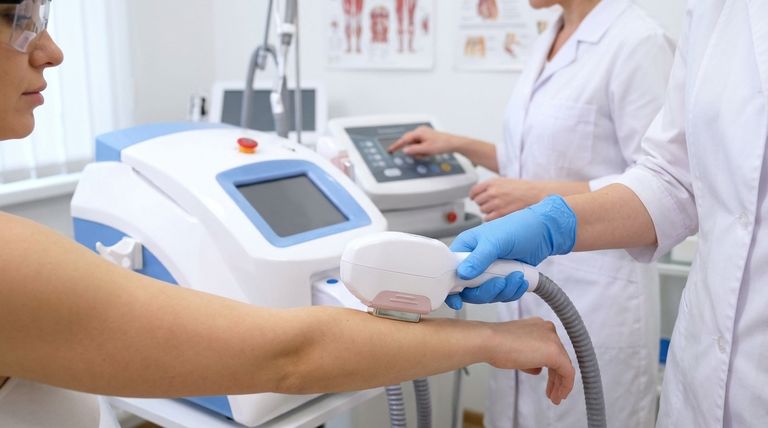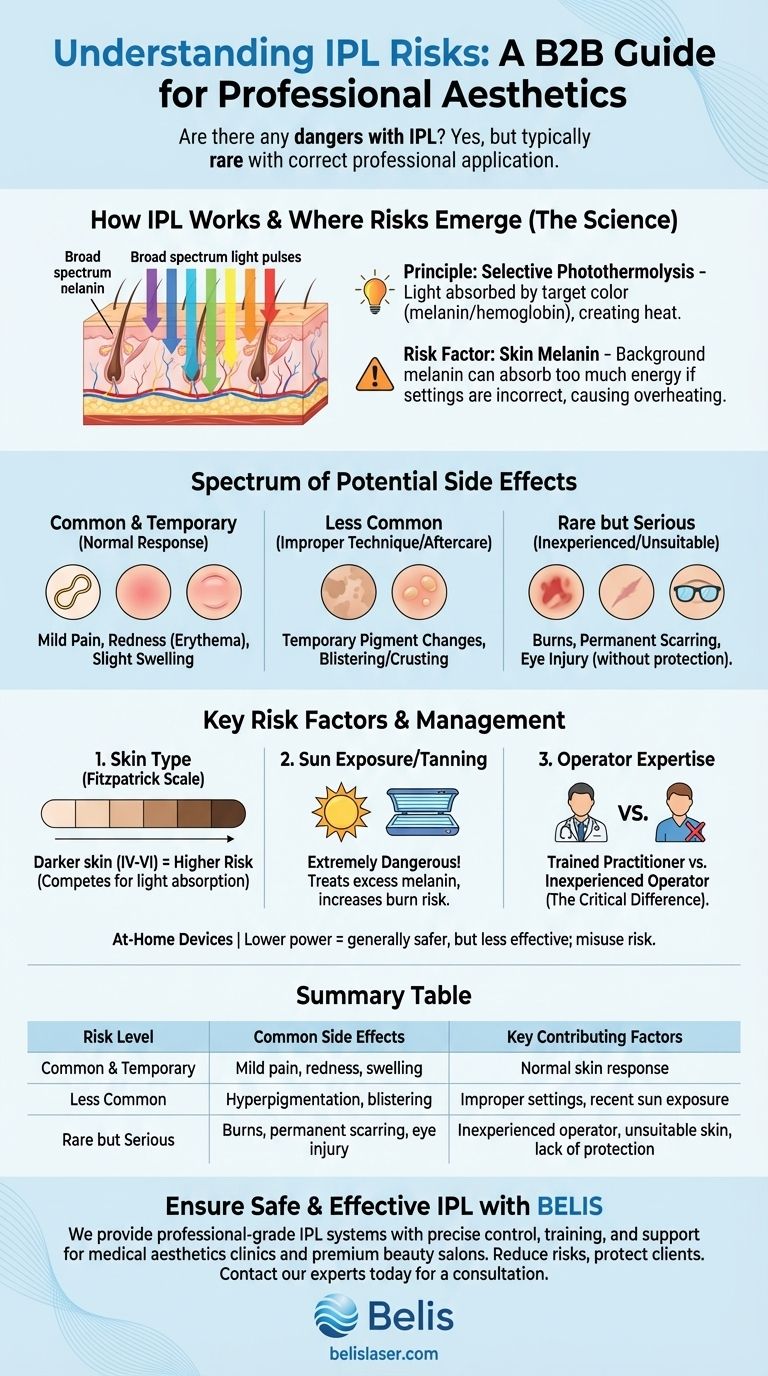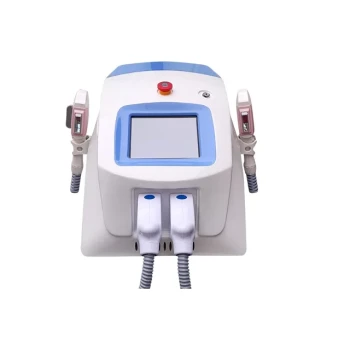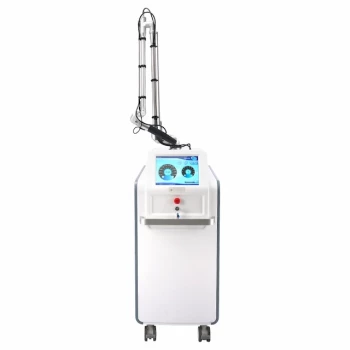Yes, there are dangers associated with IPL, although they are typically rare and minimal when the treatment is performed correctly by a qualified professional. The most common side effects are temporary and include mild pain during the procedure, redness (erythema), and slight swelling in the treated area, which usually subsides within a few hours to a few days.
While generally considered safe, the primary danger with Intense Pulsed Light (IPL) arises from improper use. The risk of adverse effects like burns or pigment changes is significantly influenced by the operator's skill, the patient's skin type, and recent sun exposure.

How IPL Works (And Where Risks Emerge)
To understand the risks, you must first understand the mechanism. IPL is not a laser; it's a device that emits a broad spectrum of light in powerful pulses.
The Principle: Targeting Color
IPL devices work on the principle of selective photothermolysis. This means the light energy is preferentially absorbed by dark pigments, known as chromophores, within the skin.
The primary targets are melanin (found in dark hair and pigmented lesions like sun spots) and hemoglobin (found in blood vessels that cause redness). When these targets absorb the light, it converts to heat, damaging or destroying them.
How This Creates Potential Side Effects
The risk emerges because the melanin in your skin can't distinguish between the "target" melanin in a hair follicle and the "background" melanin in your epidermis.
If the machine's settings are too high for your skin type, or if your skin has excess melanin from a recent tan, the skin itself can absorb too much energy. This leads to overheating and is the root cause of most significant side effects.
A Breakdown of Potential Side Effects
Risks can be categorized from common and mild to rare but more serious.
Common and Expected Reactions
These effects are often a normal part of the skin's response and are almost always temporary. They include pain (often described as a rubber band snapping against the skin), erythema (redness), and minor swelling around the treatment area.
Less Common Side Effects
These may occur, especially with improper technique or aftercare. They include temporary hyperpigmentation (darkening of the skin) or hypopigmentation (lightening of the skin). Blistering or crusting can also occur if the energy level was too aggressive for the skin.
Rare but Serious Complications
In the hands of an inexperienced operator or when used on an unsuitable candidate, more serious complications are possible. These include burns, permanent scarring, and changes in skin texture.
Furthermore, eye injury is a significant risk if proper protective eyewear is not worn by both the patient and the operator during the procedure. The intense light can cause serious and permanent retinal damage.
Understanding the Trade-offs and Key Risk Factors
Your personal risk profile is not static; it depends on several key variables. Understanding these is critical for ensuring your safety.
The Critical Role of Skin Type
The single most important factor is your skin type, often classified on the Fitzpatrick scale (from Type I, very fair, to Type VI, very dark). Individuals with darker skin tones (Type IV-VI) have more melanin in their epidermis, making them significantly more susceptible to burns and pigmentary changes because their skin competes with the target for light absorption.
Sun Exposure and Tanning
Treating tanned skin—whether from the sun or a bottle—is extremely dangerous. The excess melanin in the skin acts as a primary target for the IPL energy, dramatically increasing the risk of burns and other adverse effects. Most reputable clinics will refuse to treat recently tanned skin.
Operator Inexperience vs. Professional Expertise
A trained practitioner knows how to assess your skin type, select the appropriate filter and energy settings, and recognize subtle skin reactions during treatment. In contrast, an inexperienced operator using a "one-size-fits-all" approach is a major source of risk.
The Rise of At-Home Devices
At-home IPL devices operate at a much lower energy fluence to reduce the risk of misuse. While this makes them generally safer for home use, it also makes them less powerful and effective than professional machines. The danger lies in users ignoring safety instructions, attempting to use a device not cleared for their skin tone, or failing to protect their eyes.
How to Ensure a Safe and Effective Treatment
Your approach to IPL should be guided by your primary goal, whether it's maximum effectiveness or at-home convenience.
- If your primary focus is maximum safety and effectiveness: Seek treatment from a board-certified dermatologist or a highly experienced technician in a medical setting. A mandatory consultation and patch test are signs of a reputable provider.
- If you are considering an at-home device: Choose an FDA-cleared device from a reputable brand, be honest about your skin tone compatibility, and follow the instructions for use and eye protection without deviation.
- If you have a darker skin tone or a tan: You must exercise extreme caution. IPL may not be the safest option for you, and a professional consultation to discuss alternatives like Nd:YAG lasers is essential.
Ultimately, informed caution is your greatest asset when considering any light-based skin treatment.
Summary Table:
| Risk Level | Common Side Effects | Key Contributing Factors |
|---|---|---|
| Common & Temporary | Mild pain, redness, swelling | Normal skin response to treatment |
| Less Common | Hyperpigmentation, blistering | Improper settings, recent sun exposure |
| Rare but Serious | Burns, permanent scarring, eye injury | Inexperienced operator, unsuitable skin type (darker tones), lack of eye protection |
Ensure Your IPL Treatments Are Safe and Effective with BELIS
Choosing the right equipment and receiving proper training are the first steps toward minimizing risks and maximizing results for your clients. BELIS specializes in providing professional-grade, medically certified IPL systems designed for safety and performance in clinical settings.
We help medical aesthetics clinics and premium beauty salons by:
- Supplying advanced IPL devices with precise energy control and built-in safety features.
- Offering comprehensive operator training and support to ensure correct usage for different skin types.
- Providing reliable equipment that reduces the risk of adverse effects, protecting your clients and your reputation.
Ready to enhance your service offerings with safe, professional technology? Contact our experts today for a consultation on the best IPL solutions for your practice.
Visual Guide

Related Products
- IPL SHR Hair Removal Machine for Permanent Hair Removal
- Clinic Use IPL and SHR Hair Removal Machine with Nd Yag Laser Tattoo Removal
- Multifunctional Laser Hair Growth Machine Device for Hair Growth
- IPL SHR+Radio frecuency machine
- Multifunctional Laser Hair Growth Machine Device for Hair Growth
People Also Ask
- Does IPL hair removal really work? Unlock Long-Term Hair Reduction with Science
- Can you use hair removal device on private parts? A Guide to Safe Bikini Area IPL
- Who should not use IPL? Key Contraindications for Safe Skin Treatment
- Can IPL be used on all skin types? Understanding Risks for Darker Skin Tones
- Does IPL hair removal actually work? Achieve Long-Term Hair Reduction



















